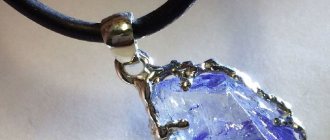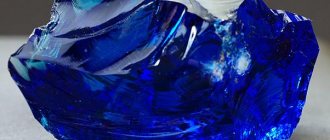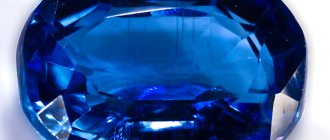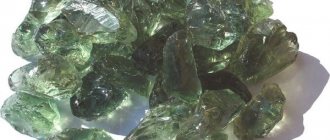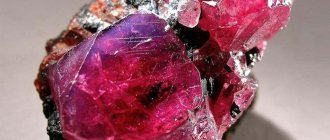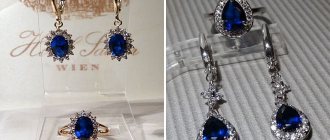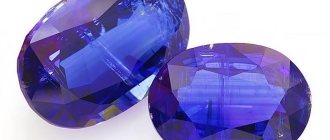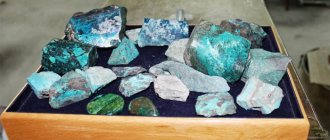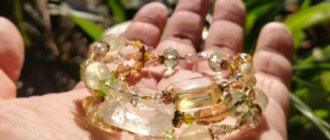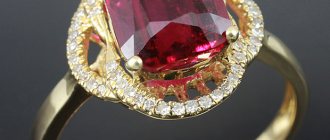Story
This blue mineral with violet tints was valued by sages, kings, and pioneers for its help in making the right decisions. Samples of iolite are found among ancient amulets and in the form of blue inserts in the eye sockets of treasure guards - snakes and idols.
In northern Europe, this gem has been known since Viking times. Scandinavian sailors did not forget to take plates of the wonderful stone on their hikes, which helped them find the way to their native shores. The fact is that if you look through such a plate at a cloudy sky, you can determine the position of the sun hidden behind the clouds. The stone was a kind of “Viking compass”.
Previously, this stone was confused with amethyst, sapphire and some other gems. Now it is already known how to distinguish iolite from them, but it is still called “water amethyst” in Madagascar, “false sapphire” in India, and “violet jade” in China.
The name iolite stone comes from the combination of two Greek words meaning violet and stone. It's surprising that this mineral has so many names. For example:
- Previously in Rus' it was called the Varangian stone.
- Jewelers call iolite water or lynx sapphire.
- Gem collectors often call it the violet stone for its vibrant purple and bluish color.
- Cordierite is what scientists usually call it. This name is given in honor of the French mining engineer Cordier.
In Russia, the violet stone was found in the Urals in 1856 during an expedition led by Academician N.I. Koksharov. However, it did not receive special attention, since brighter minerals were found there.
Decades later, it was described by Pierre Louis Antoine Cordier. Violet stone became popular in northern Europe and England. The Danish Queen Margaret and the English Princess Diana wore beautiful jewelry with it.
The largest iolite weighs 177 grams .
It is located in the British Museum in London.
Origin story
The Vikings were the first to discover cordierite and use it as a talisman. It was believed that the stone was especially useful at sea, as it helped to navigate and find the way home. In addition, the mineral saved its owner during storms and other dangerous natural phenomena. This material was discovered by the ruler of Greenland, Leif Eriksson the Happy, known for his love of long journeys.
Later the gemstone became popular throughout northern Europe. Jewelry was especially common in England. Iolite was most often worn by representatives of high ranks; it was the favorite gem of many queens.
Physicochemical characteristics
Iolite is an aluminosilicate of iron and magnesium.
- Chemical formula - ( Mg, Fe)2 Al4 Si5 O18 .
- Color - blue, purple.
- The shine is greasy and glassy.
- Transparency - transparent or translucent.
- Hardness - 7–7,5.
- Density - 2.58–2.66 g /cm3 .
This stone is usually found in the form of crystals ranging from 2 to 12 cm .
Specimens with inclusions of hematite are distinguished by a brownish color, and those with inclusions of magnetite have an increased shine. The mineral may have localized yellowing due to microscopic ingrowth of zircon and apatite.
Iolite has the effect of pleochroism, that is, when the viewing angle changes, its color changes.
Moreover, some specimens are distinguished by trichroism (three colors). If you look at such a stone from different angles, you can see three different colors: violet-blue (or gray-blue), yellow-brownish and almost colorless.
This gem is not sensitive to heat and does not fade under the sun. The properties of iolite were discovered by the ancient Vikings - they noticed that the brittle mineral could easily be cut into thin plates.
Scandinavian sailors began to use the plates as the world's first polarizing filters. They looked through the crystals as if through a lens, and determined the exact position of the sun in inclement weather and even after it had set.
How to distinguish from a fake
The lack of special education does not mean that it is impossible to distinguish a fake from iolite. The main quality of a nugget is its pleochroism. Sapphires, amestites, and other similar stones are distinguished by a uniform shade of their faces. The deep natural shade of blue and dark purple is unique to this nugget.
In addition, another clue is the sun, only iolite is capable of changing shades of color, changing in tone, following the sun's rays. Gem crystals may differ in the content of inclusions of other types, which are not found in precious stones.
With sufficient hardness, mechanical damage can lead to the formation of a conchoidal fracture. The material itself peels off in uniform pieces.
Place of Birth
Iolite is very fragile, so it is not easy to mine. The mineral is found deep underground in rocks that were formed as a result of squeezing and heating the rock.
Violet stone is mined in almost all parts of the world:
- Europe (Norway, Finland, Germany, Poland);
- Asia (India, Sri Lanka, Myanmar);
- America (Brazil, Canada, USA, Greenland);
- Africa (Zimbabwe, Mozambique, Tanzania);
- In Russia, Varangian stone is mined in the Urals, Altai, Kola Peninsula, and Karelia.
The largest (up to 12 cm) transparent purple specimens are found in Norway.
Where and how is stone mined?
Cordierite is difficult to mine because it breaks down easily. Therefore, special care is taken when working with it. Most of the mined samples are not suitable for jewelry making. The stone is mined in the following countries:
- Norway;
- India;
- Bavaria;
- Poland;
- Madagascar;
- Sri Lanka;
- Burma.
A small percentage of stones are located in Brazil and Russia. However, gems are less popular here, so mining is not as active.
Varieties and colors
Differences in iolite color occur due to various inclusions:
- Even small particles of hematite give a red brownish tint;
- yellowing appears due to the presence of zircon and apatite;
- increased brilliance, similar to flashes of bright stars, occurs due to inclusions of magnetite.
Depending on the color, iolite is called differently:
- Cordierite is a classic iolite, transparent, with blue and blue shades.
- False sapphire (pseudo-sapphire) - distinguished by its bright blue color.
- Water sapphire - has a high level of purity, glass luster. Light blue, light violet or colorless mineral.
- Lynx stone is a specimen of any color (usually blue) with a yellowish stripe in the middle, shimmering with mother-of-pearl, that is, with a cat's eye effect. If the stone is blue, then it is called lynx sapphire.
- Bloody iolite is almost cherry color.
- Inkstone is poorly cut and almost black in color.
Blue iolite samples are most prized. The deeper the blue, the more expensive the stone.
How to identify a fake
The resemblance to sapphire has led to a spate of iolite imitations. Most often it is painted glass. The production of synthetic cordierite, used for jewelry in the middle price segment, has officially been launched.
The characteristics of natural iolite help identify a fake:
- A cut gem changes color or shades when rotated or from different viewing angles. The time of day and the nature of illumination do not matter.
- Natural iolites have micro-inclusions of zircon and apatite. Visually this appears as yellowish spots.
- Natural stone, unlike glass, does not heat up in your hands instantly.
The second feature allows you to distinguish iolite from cheaper gems.
Iolite and sapphire
It is no coincidence that some varieties of iolite are called sapphires - false, water, lynx. This mineral is indeed very similar in appearance to a first-order gemstone.
Parameters that allow you to set the type of gem:
- Luster is stronger in sapphires.
- Inclusions may be present in iolite, but not in sapphire.
- Hardness and density - iolite has less, but only a specialist can verify these parameters.
- Pleochroism is the main characteristic of iolite (the stone changes color when the viewing angle changes). Sapphire does not have this optical effect. Other stones similar to iolite do not have it either - amethyst, ametrine, kyanite, tanzanite, benitoite.
Iolite or sapphire
Iolite can be passed off as sapphire and tanzanite, but these are stones of a completely different price category.
You can try to distinguish a natural gem from a fake:
- Roll the stone in your hands. With each turn, the iolite changes shade. Other (and more expensive stones) “can’t” do this.
- Iolite often contains inclusions. You won't find this in plastic or glass.
- Dichroism is another property of true cordierite. Look at the crystal first with one eye, then with the other. With true iolite, the color difference will be visible.
There are artificial iolites. Usually these are imitations made of glass.
Not verified: due to increased demand for iolite, a synthetic analogue has appeared. We recommend: Brilliant BLUE AVENTURINE
A natural, good quality stone can easily be mistaken for sapphire.
This manifested itself in other names for iolite:
- lynx sapphire;
- water sapphire;
- false sapphire.
Important: the best examples of iolite look like natural sapphire. Only a specialist can determine the difference.
Application
The main area of use of iolite is jewelry:
- Medium quality specimens are usually similar to jade or jadeite. Cabochons and amulets are made from them.
- Higher quality samples are cut with facets. When properly cut, such a stone retains color saturation, as well as pleochroism.
The gem is also in demand among collectors of mineralogical collections.
The navigational skills of the Vikings are not forgotten today. The navigators of modern liners keep an iolite plate on hand to find out the position of the sun if it is hidden by clouds.
Modern military aircraft are equipped with iolite filters. Pilots are trained to navigate in complete radio silence on the ground. Iolite helps them find the sun not only behind the clouds, but also beyond the horizon.
Mining locations
On the territory of Russia, the stone was discovered in 1856 during the Ural expedition led by Koksharov. But the mineral was not appreciated at that time.
Known mineral deposits:
- in Burma;
- Brazil;
- in Sri Lanka;
- India;
- in Madagascar;
- Tanzania;
- Ukraine;
- USA;
- Canada;
- Finland;
- Greenland.
In Russia, the mineral is mined on the Kola Peninsula, Altai and Yakutia.
Medicinal properties
Iolite has certain healing properties. The special significance of this stone for a person is that it helps maintain mental balance and normalize the psycho-emotional state, the disappearance of nervousness and depression.
To do this, it is enough to carry out a simple procedure once a day.
Take the stone in your hands, warm it and look at it for 15–20 minutes , thinking about good things.
Jewelry with iolite will help eliminate mental imbalance:
- for women - ring, earrings, hair clip or brooch;
- for men - tie pin, cufflinks.
It is believed that this mineral eliminates bad habits.
Iolite also has other medicinal properties:
- relieves insomnia (to do this you need to put it at the head of the head);
- improves the functioning of the digestive organs;
- increases the level of hemoglobin in the blood;
- neutralizes headaches;
- improves hair condition (if you wear earrings or a tiara);
- strengthens nails (when wearing a ring).
It is useful to wash your face and drink iolite-charged water in the morning on an empty stomach. This will give you energy, as the body will be cleansed of toxins and waste. To prepare such water, you need to leave a gem in a silver frame in a container with water overnight.
Healing properties of iolite
The main therapeutic effect of cordierite is maintaining mental health. The mineral calms and helps get rid of internal contradictions. The procedure associated with this stone is distinguished by its simplicity. It is enough to focus on iolite for a while to get rid of stress. Therefore, it is often used in the treatment of almost all mental illnesses. Lynx sapphire is also often used for the following problems:
- disruption of the gastrointestinal tract and liver;
- anemia;
- paralysis;
- insomnia;
- lack of hair growth or shine;
- brittle nails;
- bad habits, addiction.
It is believed that the Varangian variety most effectively removes waste and toxins from the body. Pale shades are most often used for insomnia and addiction. In other cases, bright representatives are considered more effective.
Magic properties
Iolite is popular among adherents of esoteric practices:
- The crystal facilitates the process of meditation. Contemplating it will calm your nerves and help your consciousness open up.
- Iolite is an effective amulet against envy, slander, damage, and energy vampires.
- Before going to bed, you can put a pebble or a piece of jewelry with it under your pillow and “order” a dream with a hint to get out of a difficult situation.
If you constantly carry iolite with you, intuition and the ability to foresee events will gradually develop.
Communication with iolite is of particular importance for a person who has lost hope. The stone will help you find a goal in life and the strength to achieve it.
The iolite talisman is especially suitable for those whose professional activities are related to the spiritual sphere (teachers, artists, philologists).
This gem is sometimes called the stone of the muses, as its magical properties help creative individuals find inspiration.
A talisman made from iolite is also useful for people whose profession requires quick reaction or attentiveness (rescuers, sappers, police officers, air traffic controllers, surgeons, emergency doctors, precision equipment adjusters).
The main mission of the gem is to establish relationships between people:
- helps to find love and maintain it, protecting it from betrayal;
- harmonizes the family environment;
- the strong positive energy of the stone will be useful for people prone to aggression;
- iolite helps to create and maintain friendly relationships between colleagues and friends.
This mineral will help overcome the craving for uncontrolled purchases, as well as get out of the vicious circle of debt.
The magic of iolite
The mineral stands out because it spreads positive energy around itself. That is, the product can influence not only the wearer, but also the people around him. Thanks to this, cordierite effectively protects families from any conflicts. It makes relationships between loved ones softer, calmer, which allows you to achieve complete harmony. Lynx Sapphire also has the following magical effects:
- helps get rid of debts;
- weakens the craving for continuous and unreasonable purchases;
- reduces the negative impact of stress, setting the owner to a more positive way of thinking;
- restrains impulses of aggression, uncontrolled thirst for violence;
- helps overcome excessive shyness and lack of self-confidence;
- promotes internal harmony;
- increases attentiveness and also improves perception;
- increases reaction speed.
The stone is often used in esotericism. He is able to clear the mind of obsessive thoughts. In addition, the gem can cause prophetic dreams, which can help you avoid getting into or out of a difficult situation. The mineral also protects its owner from lies, envy, and damage.
Who is suitable according to their zodiac sign?
According to the horoscope, Iolite is most energetically compatible with Libra , Taurus and Leo . It protects representatives of these zodiac signs from any troubles.
This stone can be worn by all zodiac signs. For some of them, astrologers have identified the most suitable shades of the mineral:
- For Libra , Aquarius , and Gemini, the classic “sapphire” blue color scheme is suitable.
- Leo will gain a strong amulet if he chooses a stone with a cat's eye effect.
- For Taurus , Capricorn , and Virgo , stones of cherry-red tones are suitable.
- For Scorpio , Cancer , Pisces , a suitable attribute would be “water sapphire”, that is, light blue or light purple iolite.
- For the two “fire” signs of the zodiac, Aries and Sagittarius , it has not yet been determined which types of stone affect them more strongly.
If you don’t really like the recommended shades of a gem, you can choose specimens with a different color and check your personal compatibility with them.
Types of stone and their characteristics
Iolite does not have an exact division into types. However, given the presence of a whole list of colors, it is often divided into several categories according to value, rarity and origin. These indicators also have a direct impact on the shade of the mineral. There are several colors of cordierite:
- Pale. It can be either blue or purple. Lavender-colored stones are considered the most valuable. Samples belonging to this group are mostly completely transparent.
- Violet. The stones should have a rich color without a blue tint. Can be transparent or translucent. There are both relatively light and dark representatives.
- Blue. A variety with an admixture of blue color. This coloring is the most valuable.
Sometimes a gray color of iolite is distinguished, but it is usually classified as a pale group. Such stones have virtually no color, but at the same time retain partial opacity.
How to wear
Raw iolite can be worn as a talisman without showing it to others.
Jewelry with gems can also be worn as amulets and talismans.
Iolite is suitable for people of any age, both women and men:
- For women , this stone gives a romantic look. It looks very beautiful on chiffon, silk, satin and similar fabrics in suitable shades.
- For men , examples of calm-dark colors are suitable. Cufflinks, a tie pin, and a ring will organically complement your wardrobe. It is useful to keep the stone in your personal car or on your desk as a symbol of harmony and happiness.
When choosing jewelry, you need to remember the compatibility of stone and metal. Esotericists claim that in a suitable frame, a gem will fully reveal both beauty and energy:
- It is useful to frame blue, pale blue, pale violet and transparent specimens with silver.
- Gold is suitable for the “Lynx Stone”.
How to care
In order for products with iolite to retain their beauty and magical properties for as long as possible, you must adhere to the following rules:
- When dirty, wipe the stone with a cotton swab dipped in a weak soap solution, then wipe dry.
Aggressive chemical solutions should not be used when cleaning stone.
- It is better to store the gem in a separate box so that its energy is preserved.
If the owner wears the stone every day, he needs to wash it every evening with warm running water (iolite is not afraid of high temperatures). Esotericists advise doing this because, in their opinion, this gem easily absorbs negative energy, but also easily releases it to water.
Price
Iolite belongs to the medium price category jewelry stones. It is in demand in the jewelry market, as the combination of deep blue color and good cut creates the impression of an expensive gem.
The cost of jewelry varies depending on the quality of the stone and cut, as well as the material of the setting.
The price on the world market for bright blue iolite is $55–60 per carat .
Russian online stores offer to buy iolite jewelry and material for the collection:
- cordierite cabochon (19 x 11 x 3 mm) - 250 rub. ;
- ring with iolite (925 sterling silver) — RUB 6,960. ;
- cordierite beads (beads diameter - 8 mm, beads length - 48 cm) - RUB 12,200.

